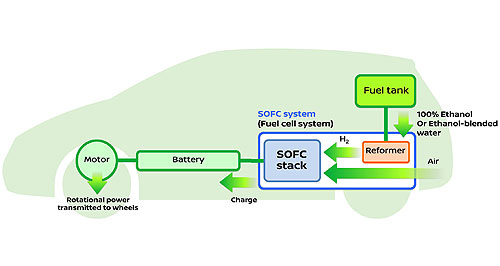Make / Model Search
News - NissanNissan evolves fuel-cell techBundy run: Nissan's experimental fuel-cell system is fuelled by ethanol that is fermented and distilled from sugarcane. Bio-Ethanol SOFC fuel cell boosts Nissan EV performance, range and efficiency16 Jun 2016 NISSAN is developing a new fuel-cell vehicle powertrain that, according to the Japanese car-maker, will allow its future electric vehicles to go further, faster and with a “carbon-neutral cycle”. Like existing fuel-cell-powered EVs, Nissan's new cell uses hydrogen to generate electricity but, until now, the fuel has been produced externally in industrial-scale processes, before being distributed to refuelling stations. While some environmentally friendly methods exist for creating the fuel, such as solar, almost all hydrogen made in Australia is through energy-heavy steam reformation of natural gas, but Nissan's system performs the conversion internally. Instead of filling the fuel tank with processed hydrogen, the Nissan system uses a more energy-dense fuel – ethanol – which is converted into hydrogen in transit, allowing a range of more than 600km, says Nissan. Another advantage of the innovation is that the ethanol can be distilled from renewable organic sources such as sugarcane or corn – dubbed e-Bio fuel – which effectively locks CO2 emissions into a continuous cycle for a carbon-neutral process. Complementing the more self-contained electricity generation process is a new type of solid oxide fuel cell (SOFC), which uses the reformed hydrogen more efficiently and has a greater output than more conventional noble metal fuel cells. “The e-Bio Fuel-Cell car’s distinct electric-drive features – including silent drive, linear start-up and brisk acceleration – allow users to enjoy the joys and comfort of a pure electric vehicle,” said Nissan. It is the first time a fuel cell of its kind has been used in a vehicle application according to Nissan, and the substitution of expensive metals such as platinum for the ceramics used in the SOFC has the potential to reduce component costs. The on-board reformer releases some carbon dioxide to the atmosphere but the only emission from the fuel-cell stack is water vapour, which is formed by combining hydrogen with atmospheric oxygen to produce electricity. As a flammable liquid, pure ethanol can pose a safety hazard, but Nissan is also trialling an experimental ethanol-blended water as a fuel for the new system, which is safer to handle and store, and is simpler to create supporting infrastructure, says Nissan. If released in a production vehicle, the Nissan EV powertrain would compete with Toyota's FCV and the ix35 Fuel Cell from Hyundai, but the pair of production fuel-cell rivals rely on gaseous hydrogen as a fuel.  Read more |
Click to shareNissan articlesResearch Nissan Motor industry news |












Facebook Twitter Instagram